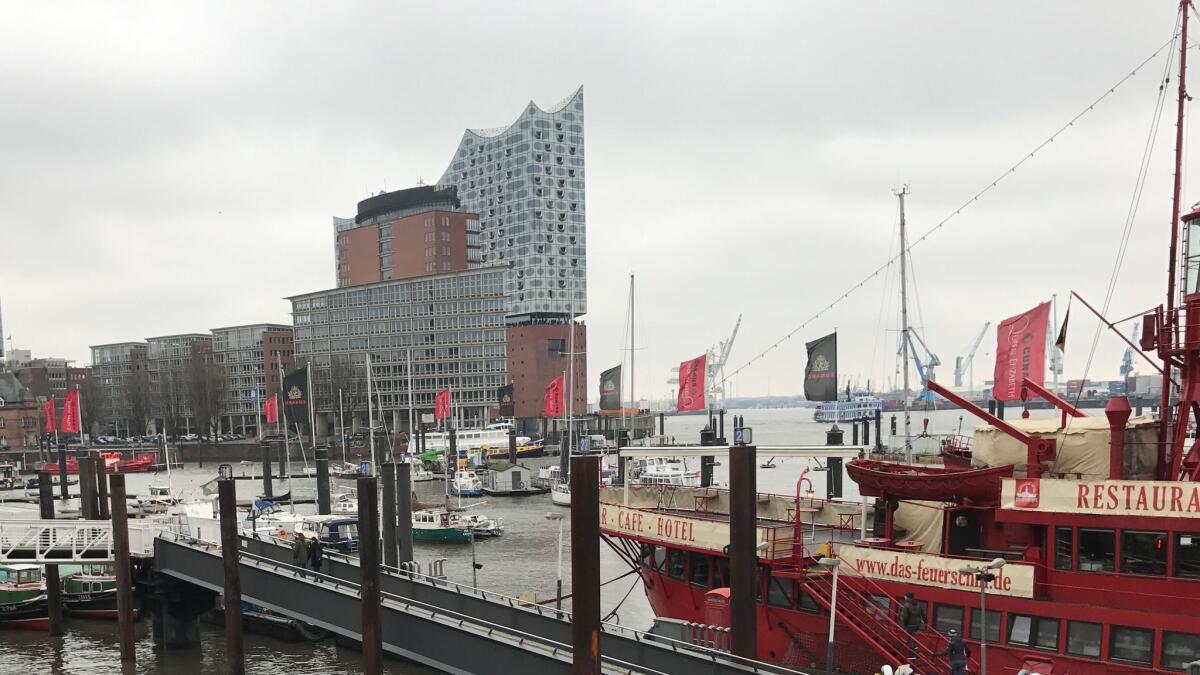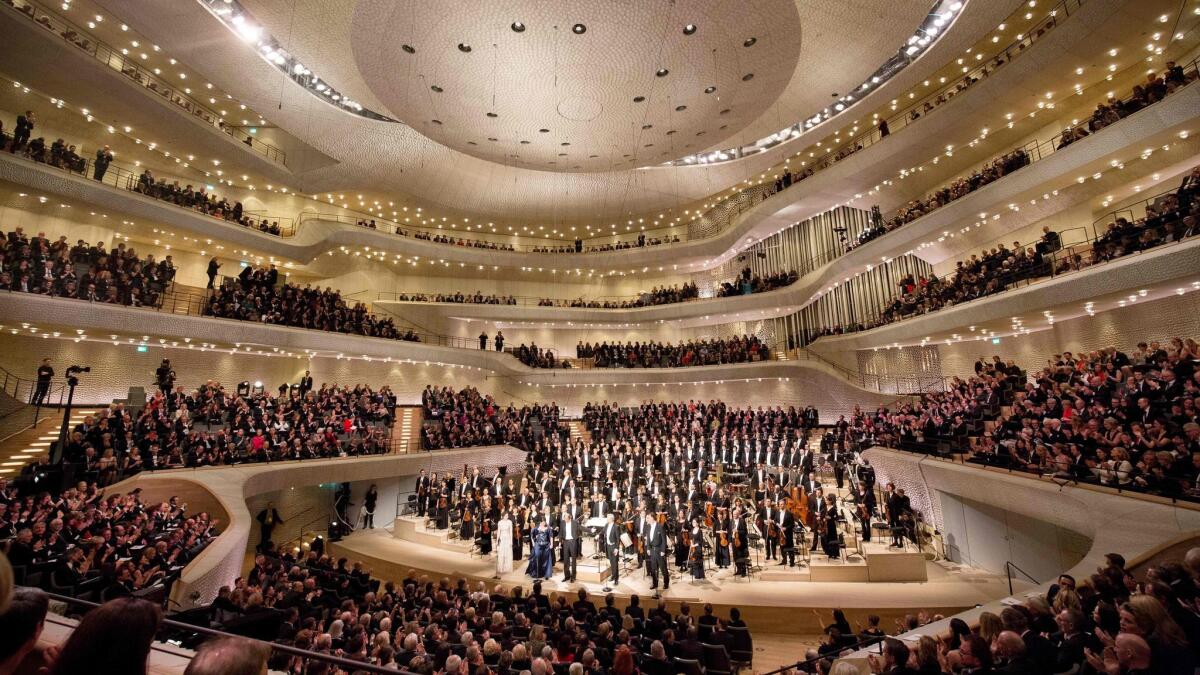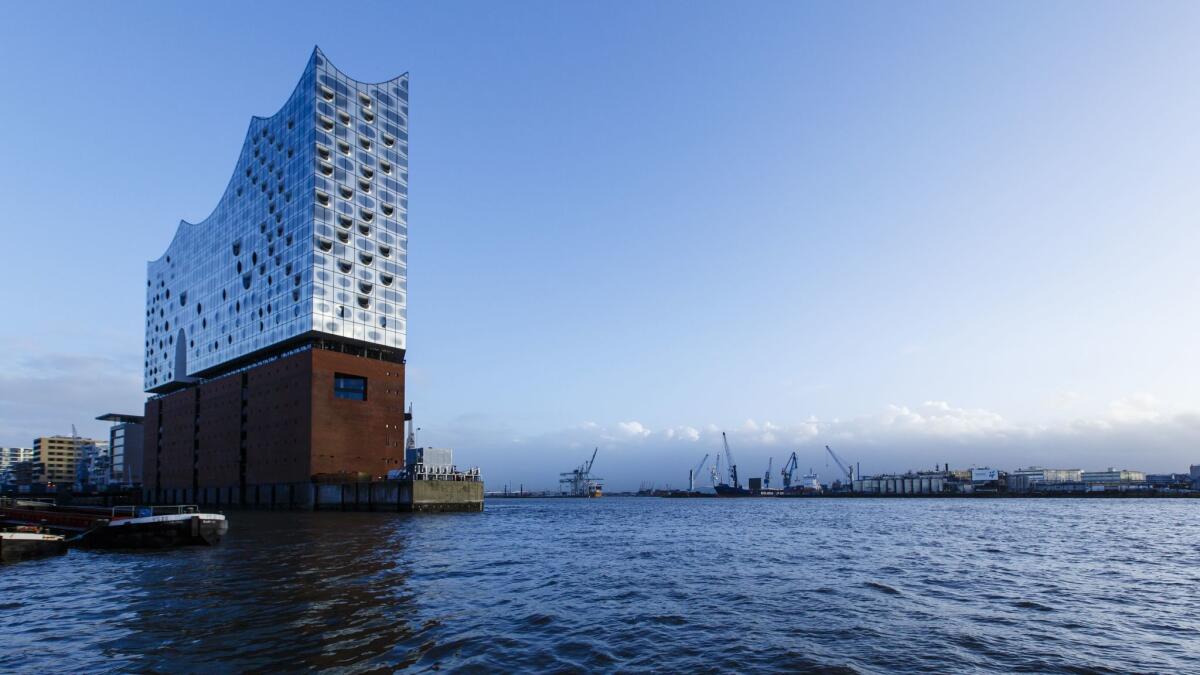Review: What does this critic hear at the new Elbphilharmonie concert hall? The sound of the future

Reporting from Hamburg, Germany — The Elbphilharmonie, which opened here in January, is the world’s most imposing concert hall. It is a sight to behold, looming over the Elbe River on Hamburg’s rapidly gentrifying harbor.
Built atop an unused wooden warehouse, the massive crystalline structure designed by the Swiss firm Herzog & de Meuron is the tallest occupied building in Hamburg and the new symbol of the city.
Tourists flock. More than a million visitors have already taken the 2½-minute ride on a curved escalator through the “launching pad” (a tube) that leads to the main public area, a plaza with a terrace where you can walk the perimeter outdoors with stunning views of the harbor and the city, have a bite to eat and hit the ample souvenir shop.
The lucky ones with tickets ascend another level to the two concert halls. Yasuhisa Toyota, the sound designer behind Walt Disney Concert Hall, created here what are said to be the world’s most advanced acoustics. The grand hall is a spectacular 2,100-seat vineyard-style auditorium, laid out with the audience surrounding the orchestra. The walls are coated with 10,000 white-gray computer-programmed honeycombed gypsum fiber panels that reflect and disperse the sound. The smaller recital hall is box-shaped and modular, with undulating-patterned wooden walls.

There are concerts most days, all sold out through August, including a large summer festival. People are preparing to pounce the moment seats for the second season go on sale, and it doesn’t seem to matter what is being performed, be it a symphony, a string quartet, new music, early music, world music, pop or anything in between.
The vast majority of the music is classical, which has excited Hamburg’s classical community no end. There are squares named for Brahms, who was born here, and Mahler, who headed the opera for six years. Telemann, Handel and, C.P.E. Bach lived and worked in Hamburg, which was a significant musical center in the baroque and classical eras. If Hamburg in the last century had somewhat fallen off the beaten track, no more.
There are obvious parallels with Disney Hall — everything from the potential for building new audiences to the Toyota acoustics to the nautical inspiration for both structures. The Elbphilharmonie looks seaworthy jutting onto the water, Frank Gehry thought of sails for L.A. Like Disney, the Elbphilharmonie was controversial and suffered delays. Unlike Disney, though, the hall is municipally funded, and the city absorbed (not without complaint) extraordinary cost overruns. Budgeted at around $250 million (a little less than the cost of Disney), the Elbphilharmonie’s final tab was more than three times that amount.
I heard a performance of Mahler’s Second Symphony played by the resident NDR Elbphilharmonie Orchestra in the grand hall and a concert of the intense last string quartets by Schubert and Shostakovich given by the Belcea Quartet in the recital hall. Elbphilharmonie, indeed, feels and sounds more like Disney than not.
It is clear that the Elbphilharmonie has been paying attention to the L.A. concert hall in more ways than one. The opening night concert began with a solo instrument and worked up, through all kinds of music, new and old, to magnificence. At Disney, it was Esa-Pekka Salonen conducting “The Rite of Spring”; here, the Elbphilharmonie’s music director, Thomas Hengelbrock, chose the Finale to Beethoven’s Ninth.
If there is a difference in the sound, it is slightly more transparency in the new hall, but nothing groundbreaking. Whether or not that is at the expense of warmth and presence was hard to tell, hearing an orchestra that was unfamiliar and that seemed to have a way to go before it too gets familiar with the hall.
The connection between the audience and the stage is even closer than in Disney, while the atmosphere is less casual. The severe seats look meant for confinement, sealing you off from your neighbor as much as possible and allowing no unnecessary movement, although they are perfectly comfortable. The combination of the interior’s honeycombed white skin and the curvaceous, layered seating areas creates the not unpleasant impression of being in a beehive.
From my seat in front, the effect was pure magic. The singers seemed to radiate from some mysterious place inside the walls.
It just so happens that Salonen opened the L.A. Phil’s first season in Disney in 2003 with a sonically cohesive performance of Mahler’s Second, the “Resurrection,” which confirmed without a doubt that Disney could do it all. The symphony begins with buzzing violins and violas and the angry sting of cellos (very bee-like in the Elbphilharmonie) and ends 90 minutes later, after painfully overcoming one of music’s great angst attacks, in wonder, with chorus, soprano and mezzo-soprano soloists, organ and a massive orchestra opening the pearly gates.
It also just so happens that the symphony owes its inspiration to this city. A lightbulb went off in Mahler’s head when he heard a chorus in Hamburg’s main church, less than a mile away from the Elbphilharmonie, sing the Resurrection Hymn. But you might not have gathered the connection at this Sunday matinee concert.
The orchestra has yet to appear at ease playing practically in the audience’s lap. Formerly the NDR Orchestra (the orchestra of radio station NDR), the newly named Elbphilharmonie has a history of working with old-world German giants. The late Günter Wand’s Bruckner with this orchestra is legendary.
Under Hengelbrock, whose main specialties are early music and new music, the playing was not secure. He alternated from laxness to overeager lunging into excitable climaxes.
But there were intriguingly strange sounds to compensate (which could have been an attempt at playing in a historic manner) that the hall’s startling clarity made especially vivid. The four harps had an exceptional prominence that I suspect Mahler would have liked. (Why else would he use four?) That the hall’s organ didn’t make much of an effect when it comes in at the end may have been how it was played.
The cramped stage left no room for a chorus, which is used only in the Finale. The singers walked on distractingly during the movement, lining the back row of seats single file. I couldn’t imagine a worse entrance or place for them, under an overhang, apart from the orchestra, and where they probably were hard to hear for the audience seated behind.
But at least from my seat in front, the effect was pure magic. The singers seemed to radiate from some mysterious place inside the walls. That was enough to know that any hall that can simultaneously reify a chorus and make you wonder whether it is even there, and any conductor who can make that happen, should be capable of anything.
There is less to say about the small recital hall. The seats are simple chairs that can be moved around. The Belcea Quartet has an intense, wiry sound that can be a little unnerving. From where I sat, fairly close to the stage, intensity and unnervingness came through to the degree that I wasn’t entirely surprised when, later that evening, I checked out the group’s website and got a warning that it was trying to install malware on my computer.
The Elbphilharmonie may be too imposing to be as lovable as Disney, but it suits stately Hamburg and succeeds brilliantly as a place where music is not meant to be taken for granted.

The unique challenge of the Elbphilharmonie, though, is to be all things to all people. It isn’t essentially a home for a visionary orchestra busily reinventing an art form, as is the case with the Los Angeles Philharmonic in Disney. Hamburg may hope that reinvention will be part of the mission, and last month, Salonen did premiere an Icelandic piano concerto with the Elbphilharmonie that is a co-commission with the L.A. Phil. But connection to Hamburg’s musical traditions is another part (as is maintaining the tourist buzz).
The city’s other two orchestras play in the hall as well, though not as resident ensembles. The Hamburg Philharmonic, which is part of Hamburg State Opera and headed by former L.A. Opera Music Director Kent Nagano, brings the vision. Its opening program for the hall was the premiere of a massive, evening-length oratorio, “Arche,” by the experimental German composer Jörg Widmann. The other orchestra is the Hamburg Symphony led by the excellent, if more conventional, British conductor Jeffrey Tate.
Along with the three orchestras comes a wealth of touring groups. Everyone apparently wants Hamburg and Hamburg apparently wants everyone. Later this month, Gustavo Dudamel arrives with his Simón Bolívar Symphony Orchestra of Venezuela for a Beethoven symphony cycle and El Sistema activities.
The civic mission is also admirable. The mayor of Hamburg has promised that every school child in the city will have an opportunity to visit the hall. There are also city-supported public training and amateur orchestras that will get their day in the Elbphilharmonie sun. Later this month, the Syrian Expat Philharmonic performs as part of a festival of Syrian music and an effort to bring Germany’s emigres into the hall. The Elbphilharmonie has even bought its own gamelan from a collector in France.
Now others want their own Elbphilharmonie. One of British Prime Minister Theresa May’s early actions was to put the kibosh on a state-supported study for building a much-needed new home for the London Symphony. That study is back on the boards with private funding, thanks to all the excitement in Hamburg,
Might the glow extend a little farther to L.A.? If Hamburg — little Hamburg — could afford all those extra hundreds of million of dollars for the Elbphilharmonie, can’t we at last come with the few million needed to realize Gehry’s many Disney Hall innovations (like video projections on the building and good lighting of the hall at night and an orchestra pit and a proper cafe) that were cost-cut out? A gamelan would be nice too.
ALSO
L.A. Phil’s 2017-18 season will build bridges, Dudamel says
Race, justice and ‘Unchained’: L.A. Phil premieres work by James Matheson
The opera about Billie Jean King’s ‘Battle of the Sexes’
L.A. Opera’s 30-year-old ‘Salome’ is back, and not a kid anymore
More to Read
The biggest entertainment stories
Get our big stories about Hollywood, film, television, music, arts, culture and more right in your inbox as soon as they publish.
You may occasionally receive promotional content from the Los Angeles Times.











